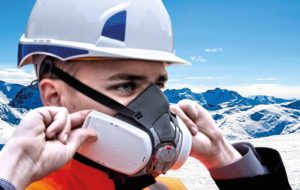Face-Fit Testing & Training

Many workers have to wear tight-fitting respiratory protective equipment (RPE) as part of their employment and it is a legal requirement that these workers be face-fit-tested by a competent person. It is therefore worth knowing what your responsibilities are as an employer with regard to fitting and maintaining RPE equipment for your employees.
Here at JB Contract Services, we are trained in face-fit-testing and can provide an on-site service as well as staff training for your employees to carry out face-fit testing internally.
How often do face-fit tests have to take place?
Singular face-fit tests have been found insufficient to protect employees and companies must carry out periodic face-fit tests for each of their affected employees. In addition to this, a maintenance record must be kept for each individual mask. The guidance from HSE is quite clear on this;
COSHH ACoP L5 Dec 2013 states: “Tight-fitting RPE (i.e. full and half masks) should be face-fit tested, using a suitable method, by a competent person (see regulation 7 of the MHSW Regulations and regulation 12(4) of COSHH).
Whenever there is a change in the equipment or, indeed, the facial characteristics of the mask wearer (such as scarring or weight loss) then a further face fit test will need to take place. To ensure that you are complying with regulations you should:
- Carry out monthly testing for frequent use, or every three months if used less frequently.
- Record your RPE examinations, tests and repairs for a least 5 years.
- Test the quality of air at least once every three months.
The issue of facial hair and face-fit tests
Anyone who has been out in public over the last three years could not have failed to notice the increase in designer facial hair, including both beards and moustaches. Guidance from HSE says that:
“The wearer needs to be clean-shaven around the face seal to achieve an effective fit when using tight-fitting facepieces. Training is a good opportunity to make employees aware of this. If workers have beards, or are unable to be clean-shaven, a tight-fitting device will not be suitable so an appropriate loose-fitting device should be chosen.”
It is therefore worth sitting down with any affected employees and asking them to think about if changing their facial hair would better protect them at work.
What happens in a face-fit test?
The face-piece fit test is a method of checking that a tight-fitting face-piece matches the wearer’s facial features and seals adequately to their face. There are two face-fit testing methods that can be used – either quantitative or qualitative. Whichever one is chosen, it must be conducted with the same exercises and conditions and with a competent, trained person in face-fit testing.
Qualitative face-fit testing
The qualitative fit test will be given on a pass/fail basis and is based on the assessment of any leakage from the face seal region by the mask-wearer sensing the introduction of a test agent. These tests are suitable for half masks, not for full face masks.
Quantitative face-fit testing
The quantitative face-fit test provides a numerical measure of the fit, which is known as a ‘fit factor’. The test requires specialised equipment and is more complicated to carry out than qualitative methods. Quantitative methods are suitable for both full and half face masks.
Key conditions of the test include:
- No smoking, drinking, eating or chewing gum for 15 minutes before the test
- No beards or stubble where the mask seals
- A test must be done for each different type of mask – so anyone wearing a dust mask and a halfmask will need more than one test
During the test a series of 60-second exercises are conducted to determine if the mask fits correctly:
- Normal breathing
- Heavy breathing – walking/stepping with the mask on
- Turning head from side to side
- Moving head up and down
- Talking
- Heavy breathing – walking/stepping with the mask on
- Normal breathing
What about mask maintenance records?
When carrying out RPE maintenance work you should ensure to adhere to the following guidance:
- Follow the manufacturer’s instructions.
- Make sure the person carrying out the maintenance is competent
- Record your maintenance records (for at least 5 years)
- Ensure appropriate intervals between maintenance
The typical types of maintenance tasks include:
- changing any replaceable filters;
- cleaning the mask;
- maintaining and replacing valves;
- observing straps for damage;
- observing battery charge and flow rate for powered devices.
Need some on-site training?
In addition to offering your company a fit-test on site, JB Contract Services can also offer workers training in how to conduct face-fit testing themselves. Our training programmes cover the following areas:
- Why RPE is needed
- How RPE works
- The hazards, risks and effects of exposure
- What RPE is being provided
- Why fit testing is required
- How to wear and check the RPE correctly
- Qualitative fit checking before use
- What maintenance is required and when
- Where and how it should be cleaned and stored
- How to report/tackle any problems
- Employee and employer responsibilities
- Use and misuse of RPE
If you require any of these services for your company, or would like a bit more information, then please contact us today, and we would be happy to discuss your requirements.


